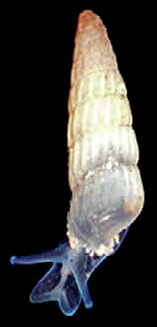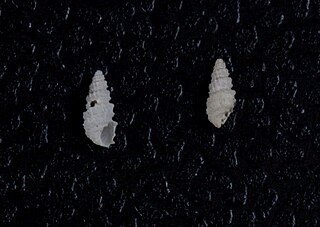| Pyramidellidae | |
|---|---|
 | |
| Live Turbonilla acutissima | |
 | |
| Apertural view of a shell of Pyramidella acus | |
| Scientific classification | |
| Domain: | Eukaryota |
| Kingdom: | Animalia |
| Phylum: | Mollusca |
| Class: | Gastropoda |
| Superfamily: | Pyramidelloidea |
| Family: | Pyramidellidae J. E. Gray, 1840 [1] |
| Type genus | |
| Pyramidella Lamarck, 1799 | |
| Synonyms | |
| |
Pyramidellidae, common name the pyram family, or pyramid shells, is a voluminous taxonomic family of mostly small and minute ectoparasitic sea snails, marine heterobranch gastropod molluscs. The great majority of species of pyrams are micromolluscs.
Contents
- Subfamilies
- 1997 taxonomy
- 1999 taxonomy
- 2005 taxonomy
- Problematic taxa
- Synonyms
- Distribution
- Shell description
- Life habits
- Name derived from shape
- References
- Further reading
- External links
The pyram family is distributed worldwide with more than 6,000 named species in more than 350 nominal genera and subgenera. [2]
This family of micromolluscs has been little studied and the phylogenetic relationships within the family are not well worked out. There is an absence of a general consensus regarding which species belong to a specific genus or subgenus, contributing to much confusion. Schander (1999) names more than 300 supraspecific names. [3] As there has been no serious generic revision of the genera worldwide, generic polyphyly can be expected to be rampant throughout the family. However, the family itself is deemed monophyletic. [4] However a study in 2011 seems to indicate that this family is deeply nested within the Pulmonata instead of the Heterobranchia. [5]
The family is currently divided into 11 subfamilies (Ponder & Lindberg 1997). [6] An alternative interpretation is that the family Pyramidellidae is but one of six families within the superfamily Pyramidelloidea (Schander, van Aartsen & Corgan 1999). [7] Many species are rare or infrequently recorded.












